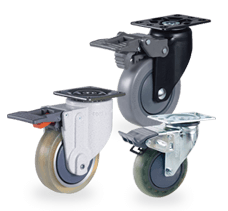Wheels are an essential component of material handling equipment and serve as the very backbone that makes the movement, storage, and management of industrial materials possible.
Wheels, with their versatility in size and material, range from lightweight plastic for light-duty applications to robust steel for heavy-duty purposes, adapting to meet the specific demands of the environment they will operate in. Carts call for basic plastic wheels, lift trucks necessitate larger, rugged wheels, and pallet jacks and conveyor systems require specialized wheels that can handle heavy loads with ease. For example, corrosive resistance might be necessary for some applications, while non-marking wheels are preferred to maintain flooring integrity.
Casters, on the other hand, are versatile wheeled devices that provide support and facilitate the movement of objects. Comprising a wheel attached to a mounting plate that fits a variety of object sizes and types, casters offer various designs, including swivel, rigid, and locking. Swivel casters, ideal for navigating tight spaces and corners, are perfect for maneuverability, while rigid casters provide stability, ideal for heavy loads. When objects require stationary positioning, locking casters come in handy.
The most important benefit of using casters is their ability to significantly reduce the amount of effort required to move items. Casters require only a minimal amount of force to roll, and they can be used on any number of surfaces, including hardwood, concrete, metal, and tile, which makes them ideal for use in a variety of environments and applications.

When it comes to choosing the right caster or wheel for your material handling needs, a number of crucial factors must be considered. The foremost factor is the load requirements, which determine the weight of the load to be moved and the dynamic load that results from the caster or wheel in motion. The environment in which the caster or wheel will be used is another critical aspect to consider, taking into account any chemical or temperature extremes as well as whether it will be used indoors or outdoors. The material of the caster or wheel must be selected to match the environment, with options ranging from rubber, polyurethane, nylon, and various metals like aluminum or steel.
The floor surface is another aspect to keep in mind, with certain materials being better suited for certain surfaces like carpet, tile, or concrete. Additionally, swivel and brake requirements should be taken into account, with swivel casters offering greater maneuverability and brakes helping to keep loads in place.
The size and style of the caster or wheel must also be considered, ensuring that the style matches the intended application and load requirements, and the size matches both the load and the available space. Lastly, it’s essential to check the warranty of the caster or wheel to guarantee coverage in case of any defects or failures.
In conclusion, casters and wheels are essential components of any material handling system as they provide the necessary mobility and maneuverability to make transporting goods and materials much easier. By choosing the right caster and wheel assembly for a particular application, businesses can ensure that their material handling operations are efficient and productive.
Feel free to visit our Engineering Blog for more informative articles.







